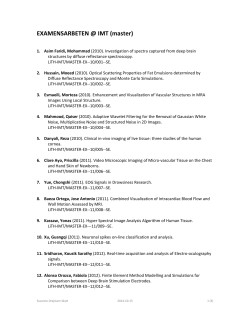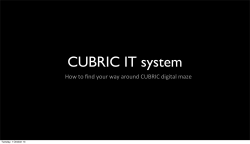
FMRI Data Analysis, from blobs to networks
Neuroscience for Engineers: FMRI Data Analysis, from blobs to networks Dimitri Van De Ville Medical Image Processing Lab, Institute of Bioengineering, Ecole Polytechnique Fédérale de Lausanne Department of Radiology & Medical Informatics, Université de Genève http://miplab.epfl.ch/teaching/ April 23, 2015 Overview Basics of functional MRI (fMRI) How to measure brain activity Task-evoked activity Brain activation maps using confirmatory analysis General Linear Model (GLM) Blobology? Resting-state/spontaneous activity Brain is organized in intrinsic functional networks Independent component analysis Graph techniques No task confound, opens new avenue for clinical fMRI Outlook Dynamic brain networks Combining fMRI with other brain measures 2 Functional brain imaging has come a long way... Head Emotional stimulus Feet [Sandrone et al., Brain, 2013; Iadecola, 2004] Balance of Angelo Mosso (1846-1910) “I said just a few words expressing the impression that his wife had made upon me when I first saw her... Cane did not speak. The blood to the brain increased immediately and the volume of the feet markedly diminished” 3 Magnetic resonance imaging (MRI) Non-invasive imaging tool to study human brain anatomy and function Tomographic technique: whole-brain coverage at 1-10 mm3 resolution Widely deployed in hospitals and research centers Endogenous contrast mechanism [Image courtesy of Shutterstock] 4 Otto Stern Physics 1943 Isidor I. Rabi Physics 1944 Felix Bloch Physics 1952 Paul C. Lauterbur Medicine 2003 Edward M. Purcell Richard R. Ernst Physics 1952 Chemistry 1991 Kurt Wütrich Chemistry 2002 Sir Peter Mansfield Medicine 2003 [Image courtesy of Shutterstock] 5 Functional MRI to study the human brain Non-invasive tool to study human brain function Unlike EEG (measured at skull) fMRI allows measures from deep inside the brain Unlike PET no radioactive tracers injected Hospitals and many research institutions equipped with MRI machines “High” spatial resolution typical = 3 mm3, very high = 1 mm3 (or less) MRI versus functional MRI (fMRI) structural MRI high resolution (1 mm) fMRI low resolution (~3 mm) Single 3D volume 1x1x1 mm3 takes couple of minutes … Series of 3D volumes 3x3x3 mm3 20-30 slices every 2-4 sec during 5-10 minutes 7 From neural activity to fMRI BOLD response 1 2 1) Neurons in a brain region are active (metabolic demand at synapse) 2) Blood flow increases locally to bring glucose and oxygen (oxygen is carried by hemoglobin in red blood cells in capillaries) neurovascular coupling 3) Increase in ratio of oxygenated to deoxygenated hemoglobin 4) Increase in BOLD (blood-oxygenation-level-dependent) response BOLD hemodynamic response function (HRF) fMRI 20 sec hemodynamic response function … Series of 3D volumes 3x3x3 mm every 2 sec during 5-10 minutes • Theoretical impulse response to short period of • neural activation Notice the response timing: ~2 sec delay, 4-6 sec to peak, up to 20 sec back to baseline Functional MRI The basic idea behind fMRI: we measure a series of MRI images over time (i.e. a movie) and we test for small fluctuations in signal intensity that are related to neural activity. fMRI voxel (in this case, 3x3x3 mm) … Series of 3D volumes 3x3x3 mm every 2-4 sec during 5-10 minutes voxel timecourse or timeseries Brain activity results in ~ 1% signal change in the voxel timecourse! 10 Tutorial fMRI experiment Three conditions Is there a face-selective brain region? Time Zzz + faces [inspired from SPM course on GLM] objects baseline 11 Tutorial fMRI experiment Is there a face-selective brain region? Ti m e Voxel 1 Voxel 2 Voxel 3 faces objects baseline 12 Model: a set of hypothetical time-series For a given voxel (time-series), we try to figure out just what type that is by “modelling” it as a linear combination of the hypothetical time-series 234 012 faces objects baseline ≈ measured β1 · 012 + β2 · “known” regressors 012 + β3 · unknown parameters 13 Model: a set of hypothetical time-series For a given voxel (time-series), we try to figure out just what type that is by “modelling” it as a linear combination of the hypothetical time-series 123 012 faces objects baseline ≈ β1 · 0.68 012 + β2 · 0.82 012 + β3 · 2.17 14 Parameter estimation What is a “best” fit? ˆ=⇧ ⇤ ⇥ 0 ⌃ 0 ⌅ 3.31 data some fit ei =0 = 17.16 i ei 2 i ei =0 = 9.47 residual error ⇥ 0.83 ⇧ ˆ = ⇤ 0.16 ⌃ ⌅ 2.98 data best fit i ei 2 i ei residual error Parameter estimation aims to reduce the sum of the squared errors (ordinary least squares method) 15 From paradigm to model specification From stimuli to modeled BOLD response Convolve stimulus time course with HRF blocks (epochs) ⊗ = ⊗ = events 16 Outcome of GLM fitting Full data representation time voxels Data (Y) = Design matrix Activation maps (beta) x estimated by OLS ⇧ ⇤ 1 2 3 ⇥ ⌃ ⌅ brain activity map with anatomical underlay followed by statistical hypothesis testing 17 18 [Jody Culham, 2012; Uttal, 2001] Overview Basics of functional MRI (fMRI) How to measure brain activity Task-evoked activity Brain activation maps using confirmatory analysis General Linear Model (GLM) Blobology? Resting-state/spontaneous activity Brain is organized in intrinsic functional networks Independent component analysis Graph techniques No task confound, opens new avenue for clinical fMRI Outlook Dynamic brain networks Combining fMRI with other brain measures 19 Resting-state fMRI GLM analysis compares evoked activity against baseline Evoked But what is baseline? Brain is 2% of body weight but consumes 20% of body’s energy Differences related to tasks explain less than 5% of total brain energy 95% are used to maintain the machine! Looking at task-related data is only the tip of the iceberg! Intrinsic [Raichle, 2009] 20 Resting-state FMRI: how it started... Systematic pattern of “de-activation” when looking at task-related data Default-mode network Functional connectivity during rest between left/right motor cortex (temporal correlation) [Biswal, 1995; Raichle et al, 2001] 21 Cocktail problem: blind source separation [Gutierrez-Osuna, Introduction to Pattern Analysis] 22 Mixing of spatial brain sources use of sources at time 1 spatial source instance of feature vector! a11 w11 a12 w12 a21 w21 a22 w22 use of sources at time 2 23 ICA... exploiting non-Gaussianity! mixing unmixing optimize unmixing based on criterion of statistical independence non-Gaussian sources [from Beckmann, FSL MELODIC] Gaussian mixtures 24 Spatial ICA For functional data Unmixing of activated brain regions from FMRI data time voxels Data (Y) = Mixing matrix Spatially independent components (S) x estimated by ICA Compare against the classical GLM time voxels Data (Y) = Design matrix x Activation maps (beta) estimated by OLS 25 ICA allows to disentangle resting state ICA reveals several large-scale brain networks Whilst parttooftask-evoked what we perceive comes through our senses [similar networks!] from the object before us, another part (and it may be the larger part) always comes out of our own head. Default-mode Dorsal attention ---network William James (1890) network Visual network Somatosensory network [Mantini et al, 2007] Auditory network Executive control/ Saliency network 26 Functional connectome Parcellation into brain regions based on atlas Pairwise correlations between regionally-averaged timecourses of all brain regions brain regions [Richiardi et al, 2013] brain regions ! 27 Functional connectome Comparing connectomes between HC and patients healthy patients assess differences in FC [Merck-Serono EPFL Research Alliance; Richiardi et al., NeuroImage, 2012] 28 Functional connectivity in development [Fair et al., 2009] resting-state functional connectivity, visualization using spring-embedding algorithm Dynamic functional connectivity Sliding window correlation in 3 healthy subjects Te m po ra l Su bc or tic al Pa rie ta l O cc ip ita l Li m bi c Fr o nt al Window length is 30 TRs, step of 2 TRs, TR=1.1sec Intriguing view on FC fluctuations [Leonardi et al, 2013] 30 Combining structure and function Function: Brain regions from resting-state ICA (default-mode) Structure Tractography on diffusion-weighted MR between DM brain regions [Damoiseaux, Greicius, 2009] 31 Combining EEG and FMRI fMRI – high spatial resolution hemodynamic response function EEG – high temporal resolution 5 10 15 20 sec 5 kHz 5000 maps / sec precisely WHEN in the brain [Adapted from J. Britz] 50.000 voxels / TR precisely WHERE in the brain 32 Thanks! Semester and Master projects in this field @ http://miplab.epfl.ch/
© Copyright 2025












